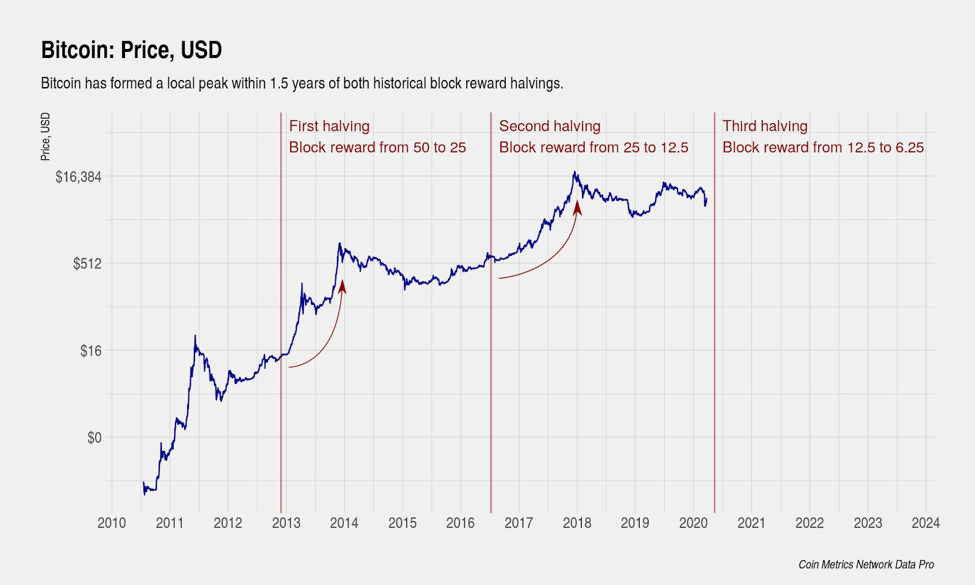You may have heard of something called a Bitcoin ‘halving’ occurring this year. In May 2020, Bitcoin went through its third halving, and its reward value dropped from 12.5 to 6.25 BTC per block mined. This essentially means that the reward for mining a block was cut in half yet again.
But how does this work?
In a centralized economy, the central bank is responsible for controlling the supply of money. However, in the case of cryptocurrencies like Bitcoin, there is no such centralized authority to control its monetary base. This necessitates that Bitcoin as a cryptocurrency must have its own mechanism to ensure a controlled supply.
This is where the concept of Bitcoin halving (or ‘halvening’) comes in. After every 210,000 blocks that are mined, the reward awarded to miners for every block gets halved. As a result, new bitcoins are released into circulation at only half the rate as compared to before that. (This is distinct from a coin burn – a mechanism that other cryptocurrencies apply to manage inflation)
Therefore, this controlled release of bitcoins helps maintain a synthetic form of Bitcoin inflation. This halving would continue till all the bitcoins have entered circulation, and after that, miners would be rewarded with the fee that network users will pay for processing transactions.
Why is Bitcoin Halving Important for Cryptocurrency Investors?
Is there any significance of this phenomenon for cryptocurrency investors? This is easier to understand when we notice the patterns that are set off by a halving event. When a halving occurs, bitcoins’ supply decreases, and the consequent higher demand leads to a rise in Bitcoin prices. And quite clearly, Bitcoin halvings in the past have resulted in a dramatic rise in Bitcoin prices, only to drop later. Let’s have a look.
- The First Halving
In November 2012, the first Bitcoin halving took place, halving the reward for mining from 50 to 25 BTC. The consequent effect on the prices saw a surge of about 8000% in the year that followed.
- The Second Halving
The second such event occurred in July 2016 when the reward was halved from 25 to 12.5 BTC, and as a result, Bitcoin prices surged by nearly 1000%.
- The Third Halving
The events of May 2020 have again led to an all-time high in Bitcoin prices, nearly reaching $20,000 in November 2020.

Therefore, crypto investors can make use of this knowledge in various ways. Understanding the market fluctuations – price rise followed by a drop – is important for anyone who intends to make gains from these market movements. At the same time, it is also important to understand the effects of other global situations, such as the ongoing pandemic, to figure out whether all halvings will necessarily result in similar price movements.
For bitcoin miners, understanding the halving of the mining reward with respect to increasing value is essential. For example, if the third halving was expected to reduce the Bitcoin inflation rate from 3.6% to 1.8%, then these changes are relevant to how the gains would be calculated. The operational costs of mining, such as hardware, electricity, etc., are estimated at $6,851 by Bitcoin.com. This corresponds to a 30% margin because 70% of the block rewards would have to be sold to cover the operational costs. So if the halvings push up the Bitcoin price but not by much, then it is not a great investment for miners (while being great for investors).
For new investors, Bitcoin halving presents a great opportunity to understand the cryptocurrency domain and begin making investments.
Conclusion
Crypto investors, particularly those holding Bitcoins for sufficient duration to make gains, can benefit greatly from such halvings. For a volatile asset, such a pattern that has occurred thrice so far seems fairly consistent.
With the next halving expected in another 4 years, it remains to be seen whether the price-boost pattern is set in stone or simply happens to coincide with other market forces.
Also you can download the app and Start Trading Now!
Android App – Bitcoin Exchange
iOS App – Cryptocurrency Exchange
Frequently Asked Questions
What Type Of Currency Is Bitcoin?
Bitcoin is a type of digital currency or cryptocurrency. In January 2009, Bitcoin was established. It's based on Satoshi Nakamoto's ideas, which he laid out in a whitepaper. The name of the individual or people who invented the technology remains unknown.
Is Bitcoin Trading Is Legal In India?
In 2020, the Supreme Court of India lifted the RBI’s restrictions on cryptocurrencies. According to the Supreme Court, the existence of Bitcoin or another cryptocurrency is unregulated but not unlawful. The verdict has greatly aided the world of digital money in the country. To put it another way, investing in Bitcoin is perfectly legal, and you may do so through various apps and traders.
What Is The Rate Of Bitcoin?
The price of Bitcoin in INR at WazirX is ₹26.8 lakhs as of June 2021. Head over to the BTC-INR exchange page on WazirX to get real-time prices.
What Is Meant By Bitcoin?
Bitcoin is a digital currency that was initially released in January 2009. It is based on ideas offered by Satoshi Nakamoto, a mysterious and pseudonymous figure, in a whitepaper. The name of the person or individuals who invented technology has not been revealed. Bitcoin promises lower transaction fees than other online payment systems, and unlike government-issued currencies, it is decentralized.
Is Bitcoin Mining Free?
Bitcoin mining isn't free, but it can be tried on a budget. Bitcoin mining is an essential part of the blockchain ledger's upkeep and development and the act of issuing new Bitcoins. It is accomplished by the use of cutting-edge computers that tackle complicated computational arithmetic problems. The effort of auditor miners is rewarded. They're in charge of ensuring that Bitcoin transactions go off without a fuss and that they're legal.
Which Cryptocurrency Is Best To Invest Now?
Litecoin has an 84 million coin limit and a 12.5 LTC block reward, which is more than other cryptos. Miners will find that mining Litecoin is faster than mining any other cryptocurrency because the average time to mine a Litecoin is under two minutes. Because of its increasing popularity, Litecoin is the best of all the altcoins. At WazirX, the current price of Litecoin is ₹12,410.22.
What Is The Meaning Of Bitcoin?
Bitcoin is a type of cryptocurrency that was first introduced in January 2009. It is invented based on the key concepts and notions presented in a whitepaper by Satoshi Nakamoto, a mysterious and pseudonymous figure. The name of the individual or people who invented technology is yet unknown. Bitcoin promises reduced transaction fees than existing online payment methods, and a decentralized authority controls it, unlike government-issued currencies.
How To Invest In Cryptocurrency In India?
There are two ways of investing in cryptocurrency, mining and via exchanges. Cryptocurrency mining is the process of verifying and adding transactions between users to the blockchain public ledger. Purchasing cryptocurrency in India is a straightforward procedure where investors simply participate by registering with a crypto exchange such as WazirX. After registering for an account, citizens can trade multiple cryptocurrencies, store cryptocurrency in wallets, and more.
How Many Bitcoins Will Ever Be Created?
The source code of Bitcoin stipulates that it must have a restricted and finite quantity. As a result, only 21 million Bitcoins will ever be generated. These Bitcoins are added to the Bitcoin supply at a predetermined rate of one block every ten minutes on average. The supply of Bitcoins will be depleted once miners have unlocked this number of Bitcoins. It's possible, however, that the protocol for Bitcoin will be altered to allow for a higher supply.
Are Cryptocurrencies A Good Investment?
Cryptocurrency has the potential to make you extremely wealthy, and the potential to cause you to lose your money. Crypto assets, like any other investment, come with many risks and potential rewards. Fundamentally, cryptocurrency is an excellent investment, particularly if you want to gain direct exposure to the demand for digital currency.
 Disclaimer: Cryptocurrency is not a legal tender and is currently unregulated. Kindly ensure that you undertake sufficient risk assessment when trading cryptocurrencies as they are often subject to high price volatility. The information provided in this section doesn't represent any investment advice or WazirX's official position. WazirX reserves the right in its sole discretion to amend or change this blog post at any time and for any reasons without prior notice.
Disclaimer: Cryptocurrency is not a legal tender and is currently unregulated. Kindly ensure that you undertake sufficient risk assessment when trading cryptocurrencies as they are often subject to high price volatility. The information provided in this section doesn't represent any investment advice or WazirX's official position. WazirX reserves the right in its sole discretion to amend or change this blog post at any time and for any reasons without prior notice.
















